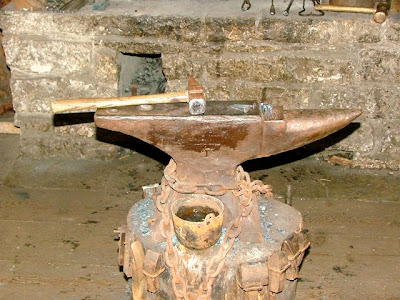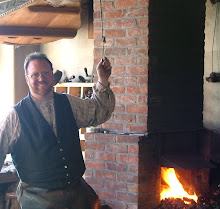Our oldest anvil is probably much like one that Mr. Peleg Field would have seen and used during his apprenticeship in the 1780’s. It is an English pattern “5th foot” anvil. That nickname comes from that fact that it has 5 feet, not 4! Chunky and squat, this style of anvil was made by teams of trained smiths working to forge the anvil from up to 11 pieces of wrought iron and then forge welding a steel plate onto the face. While often only around 120lbs, this would have been a blacksmith shop primary anvil in the 19th century. This style with the 5th foot harkens back to features found on anvils in the 17th and even 16th centuries.
This Vulcan Works anvil from Sheffield is a transitional anvil (below). Probably made in the late 18th or first third of the 19th century, it bridges the gap between the small and squat older style and the larger and longer London or American Pattern. This anvil still has the small horn of the earlier style but also has the thinner heel of the London Pattern.
The Peter Wright anvil below was made in London, England in the mid-19th century. It is the shape that most people recognize in the United States as a modern anvil. It is around 155lbs. The larger horn and long thin heel of the anvil face makes this a versatile tool. This is the anvil we use at the front forge in the Field Blacksmith shop.
At the back forge is a larger anvil made in the same style as the Peter Wright at the front forge. Larger than the previous anvil, it is around 180lbs. You can feel the benefit of that extra mass when using it. It provides a very solid surface for larger work like hinges and wagon parts.
Anvils were such common tools in daily life and last such a long time, that there is a surprising amount of diversity among old anvils. Unlike other items that are 150 to 300 years old, anvils are generally considered tools rather than antiques. With good care, these anvils will be in use as we work and demonstrate to the public for decades to come.





